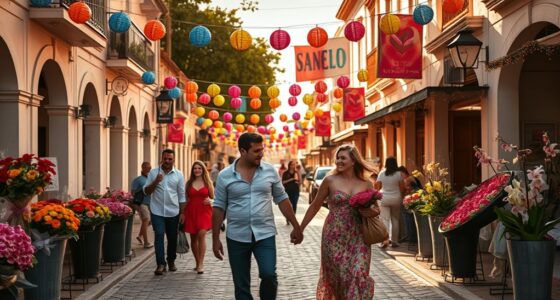Imagine a time when ancient Roman streets echoed with the sounds of fertility festivals, where rituals and sacrifices celebrated renewal and community bonds. As centuries passed, these rites transformed into stories of love and sacrifice, shaping a holiday we now know as Valentine’s Day. But how did this day evolve from ancient traditions into a global symbol of romance? The journey is more complex—and fascinating—than many realize.
Key Takeaways
- Valentine’s Day originates from ancient Roman fertility festivals like Lupercalia, blending sacred rites with community celebration.
- The legend of Saint Valentine highlights acts of love, sacrifice, and miracles, symbolizing love’s divine power.
- Medieval traditions used love tokens and secret meetings, fostering symbolic expressions of devotion and emotional bonds.
- The holiday has evolved into a commercial event, emphasizing gift-giving and modern romantic gestures worldwide.
- Misconceptions often obscure its roots, which lie in ancient fertility rites and stories of love overcoming adversity.
Origins of Roman Fertility Festivals

Roman fertility festivals date back to ancient times when they played a crucial role in agricultural and societal rituals. These Roman festivals centered on fertility rituals designed to ensure a bountiful harvest and healthy offspring. During these celebrations, people performed customs that symbolized fertility, such as offering sacrifices and engaging in playful public acts. The most significant of these was the Lupercalia, held in mid-February, which involved rituals to promote fertility for both land and people. These festivals not only strengthened community bonds but also reinforced cultural beliefs about renewal and abundance. Over time, Roman festivals like these laid the groundwork for later traditions, blending sacred rites with communal joy, shaping the cultural landscape of fertility celebrations that influence modern customs. The use of sacrificial offerings was central to these rituals, symbolizing the community’s hope for prosperity and renewal.
The Legend of Saint Valentine
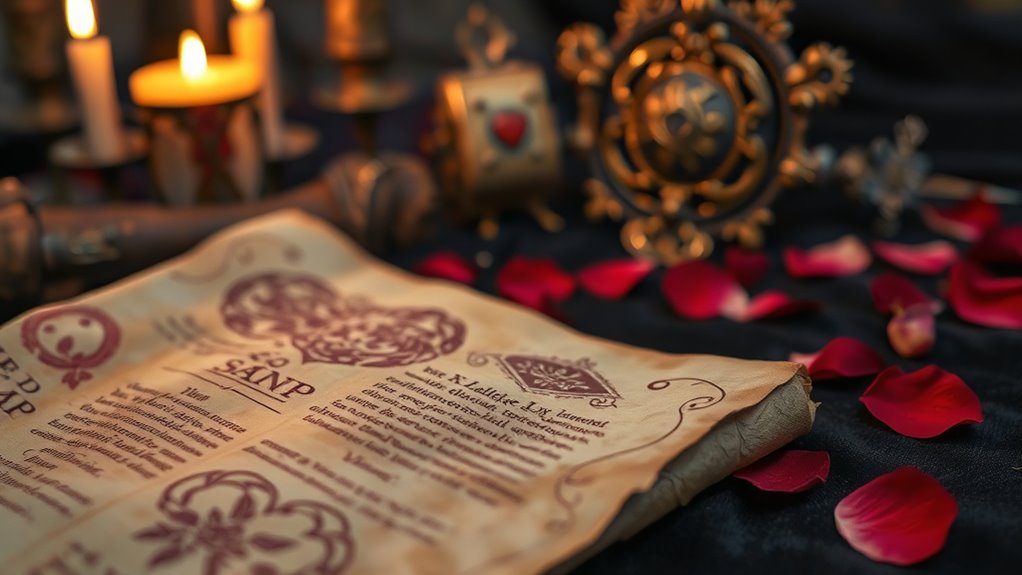
You’ve probably heard that Saint Valentine’s story involves acts of kindness and miracles. His origins are shrouded in legend, but many believe he was a compassionate figure who defied authorities to help lovers. As the patron of lovers, his story continues to inspire romantic traditions today. His legacy is also celebrated through architectural solutions that create spaces for love and connection.
Saint Valentine’s Origins
Have you ever wondered where the story of Saint Valentine comes from? The origins are shrouded in legend, but many believe he was a compassionate priest who secretly married couples in defiance of Roman laws. Over time, stories grew around him, often linking him to love and romance. Some tales suggest Cupid’s and Cupid’s arrows symbolize his influence, inspiring love and affection. Chocolates and chocolates didn’t become part of Valentine’s Day until much later, but they now serve as sweet tokens of love, echoing the ancient desire to celebrate affection. Today, Saint Valentine’s story is intertwined with these symbols, but his true legacy lies in his act of kindness and love, which continues to inspire modern romance. Modern noise levels of heating systems also aim to maintain comfort without disturbing the peaceful ambiance of romantic gatherings.
Legends and Miracles
Many stories about Saint Valentine highlight miraculous events and extraordinary acts that emphasize his unwavering compassion. Romantic legends recount how he secretly married couples, defying Roman laws, and performed miracle tales that inspired hope and love. One famous miracle tale tells of how he restored sight to a young girl, demonstrating his divine connection and kindness. Horsepower of electric dirt bikes These stories often portray him as a figure who defied injustice through acts of love and faith. His life became intertwined with miracle tales that reinforced his reputation as a healer and protector of lovers. These romantic legends and miracle stories continue to symbolize the power of love overcoming adversity, shaping the enduring myth of Saint Valentine as a compassionate and miraculous figure in history.
Patron of Lovers
The legend of Saint Valentine as the patron of lovers has endured for centuries, symbolizing the power of love to triumph over obstacles. In romantic mythology, Saint Valentine’s story exemplifies unwavering devotion and sacrifice, inspiring countless love stories across generations. His act of secretly uniting couples in marriage became a powerful love symbolism, representing hope and fidelity amid adversity. As the patron of lovers, he embodies the idea that love can defy societal barriers and official mandates. This enduring legend reinforces the notion that romance, faith, and sacrifice are central to the celebration of love. Today, his story continues to inspire expressions of affection and the belief that love is a force capable of overcoming all challenges. Additionally, the natural beauty of New England provides an ideal backdrop for romantic getaways, echoing the timeless themes of love and devotion.
Medieval Traditions and Love Symbols
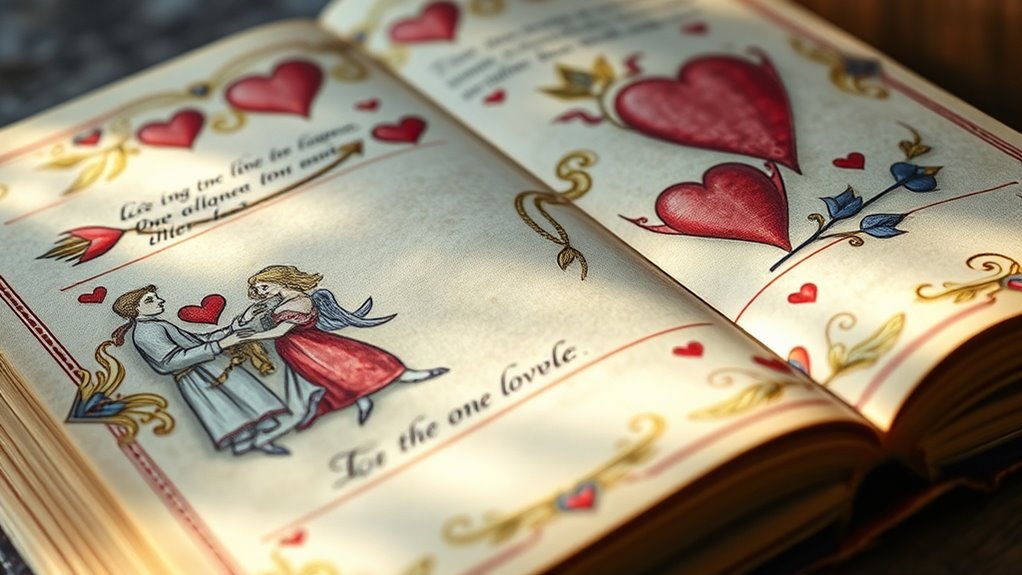
During the medieval period, lovers often expressed their affection through symbolic gestures and rituals that cemented their bonds. Medieval courtship involved exchanging love tokens, such as rings, knots, or small gifts, to demonstrate devotion. These tokens served as tangible symbols of commitment and hope for future union. Lovers also participated in rituals like love writing and secret meetings, reinforcing their emotional connection. Courtship was often marked by playful symbols, like heart-shaped items or flowers, to communicate affection discreetly. These traditions created a language of love rooted in symbolism, allowing lovers to express feelings in a society where open romance was sometimes restricted. Your understanding of medieval love symbols reveals how deeply gestures and tokens helped forge lasting emotional bonds.
The Evolution of Romantic Customs

You’ve probably noticed how romantic customs have changed over time, from ancient courtship rituals to the symbols we use today. Valentine’s Day symbols like hearts and roses have evolved from historical meanings to modern icons of love. Now, you see trends like personalized gifts and digital messages shaping how people express their affection. Incorporating quirky-shaped planters into gift ideas has gained popularity as a unique way to show thoughtfulness and creativity.
Ancient Courtship Practices
Ancient societies often relied on elaborate rituals and symbolic gestures to express romantic interest, shaping the earliest forms of courtship. These courtship rituals involved actions like gift-giving, poetry, and public displays of affection, setting foundational romantic rituals. You might have participated in rituals such as exchanging tokens or performing dances to demonstrate your affection. Understanding these practices helps you see how romantic customs evolved from simple symbols to complex traditions. The table below highlights different ancient courtship rituals across cultures: | Culture | Courtship Practice | |———–|———————————–| | Greece | Gift exchanges and poetry | | Rome | Public displays and symbolic gestures | | Egypt | Love songs and dance | | China | Gift-giving and ancestral rituals | Ancient societies also valued natural materials, such as flowers and handcrafted tokens, to symbolize love and affection in their courtship customs.
Valentine’s Day Symbols
Valentine’s Day symbols have evolved over centuries from simple gestures to widely recognized icons of love. You now see hearts symbolism everywhere—on cards, jewelry, and decorations—representing deep affection and emotional connection. The heart shape, with its timeless appeal, became a universal symbol of love by the Middle Ages. Cupid imagery also plays a central role, originating from Roman mythology, where Cupid’s arrow sparks romantic desire. Over time, these symbols transformed from modest tokens to powerful images that communicate love instantly. Today, they evoke feelings of warmth and romance, bridging centuries of tradition. You can’t help but associate hearts and Cupid with Valentine’s Day, as they continue to embody the essence of romantic affection in modern celebrations. Additionally, the widespread use of these symbols is supported by their cultural significance, which ensures their enduring popularity.
Modern Romantic Trends
Modern romantic customs have transformed considerably over recent decades, influenced by technological advances and changing social attitudes. Today, you might see new ways of expressing love through romantic gestures and shifting gift giving trends. Instead of traditional bouquets, digital gifts and personalized experiences have gained popularity. Here are some key trends:
- Virtual dates and online romantic gestures, making intimacy possible across distances.
- Customized gifts, such as engraved jewelry or bespoke experiences, emphasizing personal connection.
- Social media expressions of love, where sharing heartfelt messages or public declarations become part of modern romance.
- Personality insights can help partners better understand each other’s preferences and communication styles, fostering deeper connections.
These changes reflect a move toward more personalized and accessible ways to celebrate love, blending tradition with innovation. You now have more options than ever to show affection, making each gesture meaningful and memorable.
The Role of Literature and Poetry
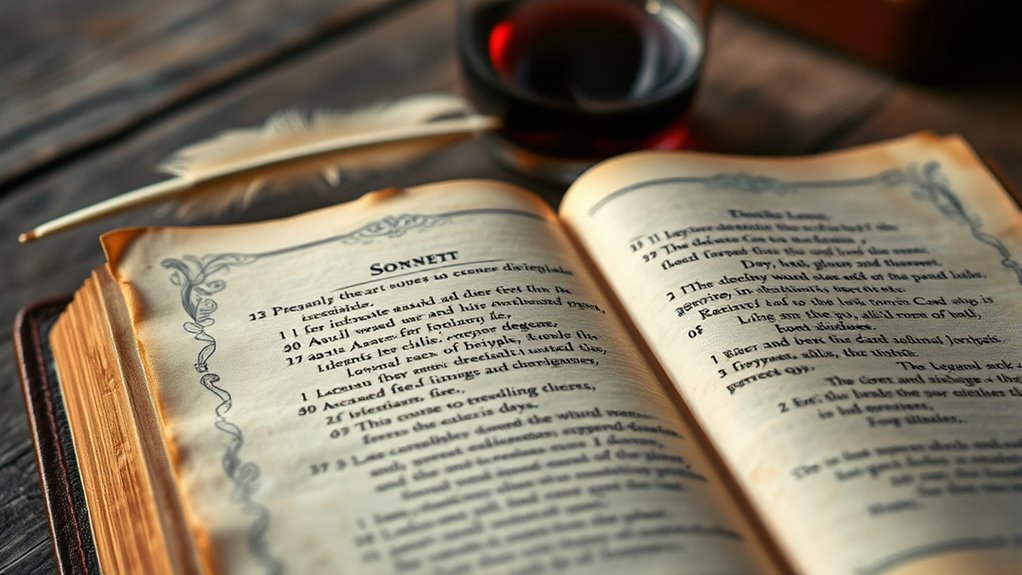
Literature and poetry have long shaped how people express love and celebrate romantic connections, especially around Valentine’s Day. Love sonnets, in particular, became a powerful way to convey deep affection and admiration, often capturing the nuances of romantic longing. Poets used poetic symbolism to represent love’s complexities, turning abstract emotions into vivid imagery that resonated with readers. These works helped elevate romantic expressions from simple gestures to artful declarations, inspiring lovers to craft their own heartfelt messages. Through centuries, poetry has served as a bridge, translating feelings into words that evoke passion and tenderness. The use of romantic symbolism in poetry has allowed writers to explore and express love’s many facets with nuance and depth. As a result, literature remains a cornerstone of Valentine’s Day, reminding us of love’s enduring capacity to inspire beauty and connection through poetic language.
Commercialization and Modern Celebrations
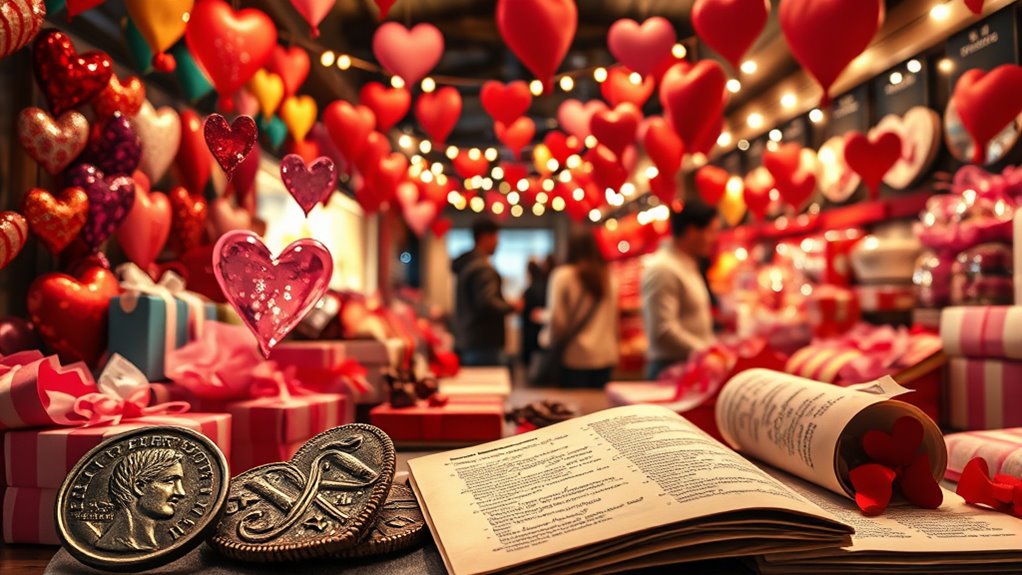
Over time, the celebration of love has become increasingly driven by commercial interests, transforming Valentine’s Day into a major retail event. You’ll notice this shift through the rise of gift-giving traditions such as:
- Purchasing gourmet chocolates to indulge your loved ones.
- Sending or buying floral arrangements to brighten their day.
- Shopping for romantic cards, jewelry, and other tokens of affection.
Retailers capitalize on these customs, promoting sales with special offers and themed displays. The holiday now emphasizes material expressions of love, often overshadowing its historical and cultural roots. You’re encouraged to participate in this commercial cycle, making the day not just about genuine affection but also about consumer spending. This transformation highlights how modern celebrations often blend sentiment with commercial interests.
Cultural Variations Around the World
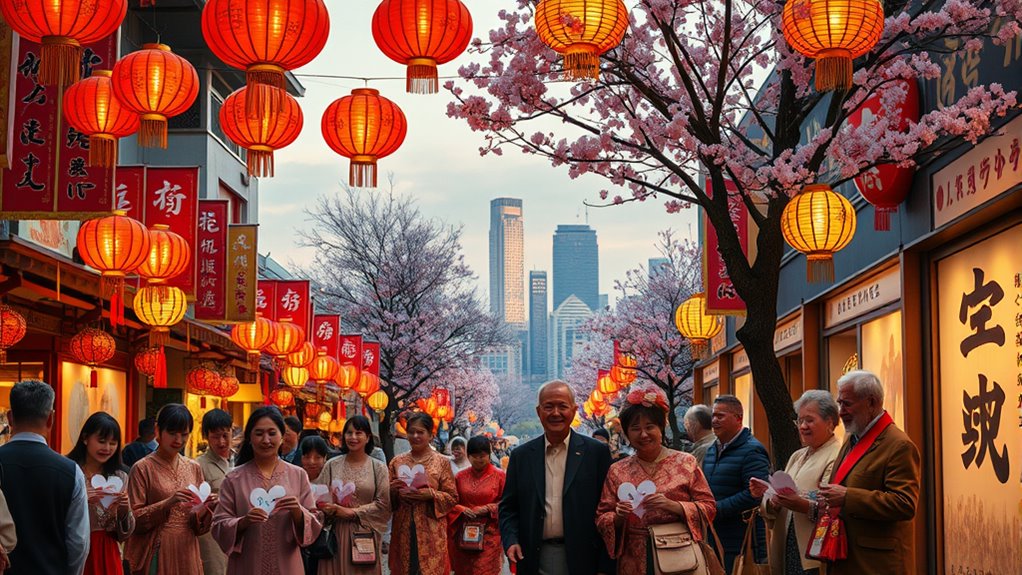
Have you ever wondered how different cultures celebrate love on Valentine’s Day? You’ll find that cultural differences shape unique customs around the world. In Japan, women give chocolates to men, while men reciprocate later. In South Korea, the holiday is extended with a “White Day” for gift exchanges. In Brazil, lovers celebrate on June 12th during Dia dos Namorados, with lively festivals and romantic dinners. In Finland and Estonia, Valentine’s Day focuses on friendship and appreciation, not just romantic love. These international customs highlight how varied traditions can be, reflecting each society’s values. Understanding these cultural differences enriches your perspective, showing that love’s celebration isn’t universal but shaped by local history and social norms. It’s a beautiful mosaic of love worldwide.
Myths and Misconceptions About the Holiday
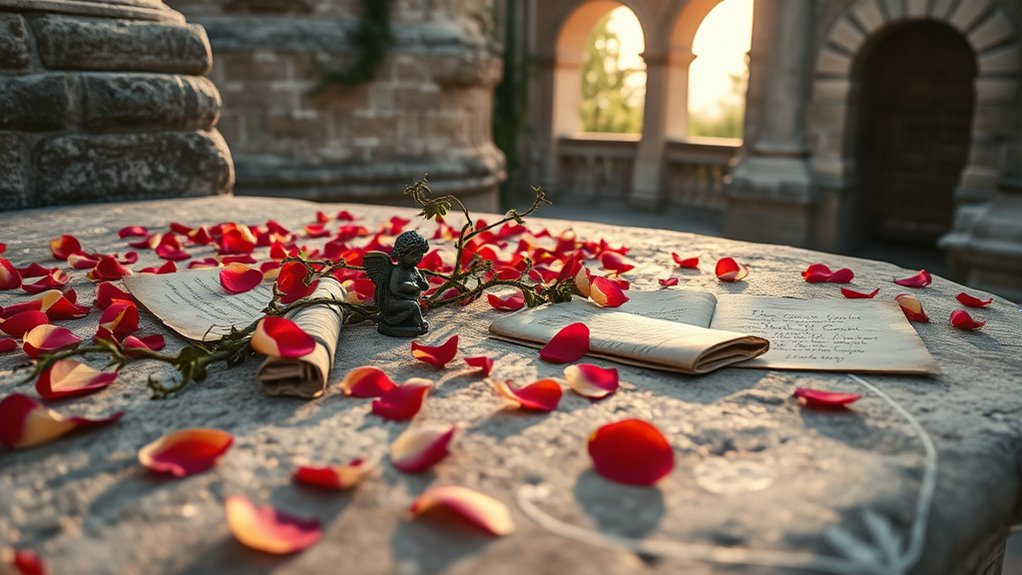
Many people assume that Valentine’s Day has always been solely about romantic love, but this isn’t entirely true. Over time, superstitions myths and historical misconceptions have shaped how we view the holiday. For example:
- Some believe that celebrating on February 14 guarantees love, but it’s a modern superstition rather than a historical fact.
- Many think that Valentine’s Day originated solely from romantic legends, ignoring its roots in ancient Roman rituals.
- Others assume that pairing of lovers on this day has always been the tradition, overlooking earlier customs involving friendship and community.
These myths cloud the true history of Valentine’s Day, often distorting its origins and significance. Recognizing these misconceptions helps you appreciate the holiday’s complex evolution beyond just modern romantic ideals.
The Future of Valentine’s Day Celebrations

As society continues to evolve, so do the ways we celebrate Valentine’s Day, reflecting changing attitudes and technological advancements. Future innovations will likely transform how you express love, making celebrations more personalized and interactive. Technological enhancements, like virtual reality, could enable you to share experiences with loved ones across great distances, creating immersive moments no matter where you are. Smart gadgets may allow for customized gifts or messages that adapt to your partner’s preferences in real-time. Expect more digital experiences, like augmented reality cards or AI-generated surprises, to become common. These innovations will make Valentine’s Day more accessible and inclusive, allowing you to celebrate in unique ways that blend tradition with cutting-edge technology. The future promises a more connected, creative, and dynamic holiday for everyone.
Frequently Asked Questions
How Did Valentine’s Day Become Associated With Romantic Love?
You might wonder how Valentine’s Day became linked to romantic love. The historical origins trace back to ancient Roman rituals honoring St. Valentine, but it was cultural influences during the Middle Ages that solidified its romantic meaning. People started exchanging love notes and tokens, especially in England and France, which helped establish the holiday as a celebration of love. Over time, these traditions spread, shaping our modern view of Valentine’s Day as a day for romance.
Are There Any Lesser-Known Ancient Rituals Linked to Valentine’S Day?
You might find that ancient fertility rites and secret matchmaking ceremonies are lesser-known rituals linked to Valentine’s Day. In some cultures, people performed secret ceremonies to promote love and fertility, believing these rituals would bring good fortune. These obscure practices, often hidden from mainstream history, reveal how Valentine’s Day evolved from these mystical traditions into a celebration of love and romance we recognize today.
What Are Some Obscure Symbols Historically Used to Express Love?
You might find it fascinating that secret symbols and love tokens have long conveyed affection. In history, things like carved amulets, knotted ribbons, or even specific flowers served as obscure symbols of love. These tokens, often hidden or exchanged privately, carried meanings understood only by lovers. Such secret symbols allowed people to express their feelings subtly, making the act of love more intimate and mysterious across different cultures and eras.
How Do Non-Western Cultures Celebrate Romantic Relationships?
Did you know that in Japan, women give chocolates to men on Valentine’s Day, with 70% of women participating? In many non-western cultures, love rituals and cultural expressions of romance vary widely. For example, in India, arranged marriages are common, emphasizing family and societal bonds over individual romantic gestures. In Japan and Korea, love is often expressed through unique gift-giving customs, showcasing diverse ways cultures celebrate romantic relationships beyond Western traditions.
What Are Emerging Trends in Valentine’s Day Celebrations Worldwide?
You see that emerging trends on Valentine’s Day include digital dating, where couples connect virtually and celebrate online, especially during travel restrictions. Eco-friendly gifts are gaining popularity as people become more conscious of sustainability. You might also notice personalized experiences, like virtual concerts or handmade presents, reflecting shifting preferences for meaningful, environmentally conscious celebrations. These trends highlight how modern couples adapt traditions to suit a more connected and eco-aware world.
Conclusion
So, here you are, caught in the whirlwind of Cupid’s arrows and commercial chaos. From ancient rites to retail racks, Valentine’s Day keeps reinventing itself—still promising love while subtly selling everything from chocolates to heartbreak. Whether you’re a hopeless romantic or just here for the freebies, remember: love’s the real gift, not the overpriced teddy bear. So, go ahead, celebrate—just don’t forget to check your wallet at the door.


